UC-405
SAND96-8216
Unlimited Release
Printed May 1996
CHEMKIN-III: A FORTRAN CHEMICAL KINETICS PACKAGE FOR THE ANALYSIS OF GAS-
PHASE CHEMICAL AND PLASMA KINETICS
Robert J. Kee, Fran M. Rupley, and Ellen Meeks
Thermal and Plasma Processes Department
and
James A. Miller
Combustion Chemistry Department
Sandia National Laboratories
Livermore, CA 94551-0969
ABSTRACT
This document is the user's manual for the third-generation CHEMKIN package. CHEMKIN is a
software package whose purpose is to facilitate the formation, solution, and interpretation of problems
involving elementary gas-phase chemical kinetics. It provides a flexible and powerful tool for
incorporating complex chemical kinetics into simulations of fluid dynamics. The package consists of
two major software components: an Interpreter and a Gas-Phase Subroutine Library. The Interpreter is
a program that reads a symbolic description of an elementary, user-specified chemical reaction
mechanism. One output from the Interpreter is a data file that forms a link to the Gas-Phase
Subroutine Library. This library is a collection of about 100 highly modular FORTRAN subroutines that
may be called to return information on equations of state, thermodynamic properties, and chemical
production rates. CHEMKIN-III includes capabilities for treating multi-fluid plasma systems, that are
not in thermal equilibrium. These new capabilities allow researchers to describe chemistry systems
that are characterized by more than one temperature, in which reactions may depend on temperatures
associated with different species; i.e. reactions may be driven by collisions with electrons, ions, or
charge-neutral species. These new features have been implemented in such a way as to require little or
no changes to CHEMKIN implementation for systems in thermal equilibrium, where all species share
the same gas temperature.
3
�
ACKNOWLEDGMENTS
CHEMKIN-III now has the capability to handle weakly ionized plasma chemistry, especially
for applications related to advanced semiconductor processing. This aspect of the work was supported,
in large part, through a Cooperative Research and Development Agreement (CRADA) with
SEMATECH. Dr. Andrew Labun, at Digital Equipment Corporation, has been very generous of his time
and energies in suggesting the ways in which CHEMKIN can better meet the needs of the advanced
semiconductor processing industry. Prof. Mark Cappelli at Stanford University provided an initial
vision, which established the technical direction for the multi-fluid formulation that is implemented
in CHEMKIN-III.
CHEMKIN-III also has enhanced capabilities to handle a variety of pressure-dependent
unimolecular-falloff and bimolecular chemically activated processes. Dr. Gregory Smith of SRI
International and Dr. Jan Hessler of Argonne National Laboratory were instrumental in establishing
the technical formulations and provided important suggestions on the software implementation.
Finally, we are grateful to our many colleagues at Sandia and elsewhere, who have provided
numerous suggestions and have patiently worked with us as applications have migrated from
CHEMKIN-II to CHEMKIN-III. In particular, we acknowledge the efforts of Drs. Michael Coltrin,
Gregory Evans, Joseph Grcar, Pauline Ho, William Houf, Richard Larson, Andrew Lutz, Chris Moen,
Harry Moffat, and Jong Shon.
4
�
CONTENTS
Page
II.
6
LIST OF FIGURES...........................................................................................................................
6
LIST OF TABLES ............................................................................................................................
7
NOMENCLATURE.........................................................................................................................
9
INTRODUCTION..................................................................................................................
I.
9
Background.........................................................................................................................
10
Structure and Use of CHEMKIN.........................................................................................
11
Example for a Single-Temperature Neutral Gas: Hydrogen Oxidation................................
14
Example for a Multi-Temperature Plasma..........................................................................
Transportability...............................................................................................................
16
16
Organization of this Report...............................................................................................
18
THERMODYNAMICS AND CHEMICAL RATE EXPRESSIONS ...........................................
Choice of Variables ..........................................................................................................
18
18
Equation of State and Conversion Formulas ........................................................................
21
Standard-State Thermodynamic Properties.......................................................................
25
Chemical Reaction Rate Expressions..................................................................................
III. THE MECHANICS OF USING CHEMKIN...........................................................................
36
36
Structure of CHEMKIN .....................................................................................................
38
Job Control ........................................................................................................................
IV. USING THE INTERPRETER.................................................................................................
39
39
Element Data....................................................................................................................
42
Species Data.....................................................................................................................
43
Thermodynamic Data .......................................................................................................
Reaction Mechanism Description.......................................................................................
46
59
V. QUICK REFERENCE GUIDE TO THE GAS-PHASE SUBROUTINE LIBRARY ......................
Mnemonics ........................................................................................................................
59
VI. ALPHABETICAL LISTING OF THE GAS-PHASE SUBROUTINE LIBRARY WITH
VII.
DETAILED DESCRIPTIONS OF THE CALL LISTS ...............................................................
SAMPLE PROBLEM ...........................................................................................................
1. UNIX Shell Script for Running the Sample Problem ....................................................
2. Sample Input to the Interpreter....................................................................................
3. Output from the Interpreter for the Sample Input..........................................................
4. Sample User’s FORTRAN Code: CONP .......................................................................
5. Input to the Sample FORTRAN Code, CONP...............................................................
6. Output form the Sample FORTRAN Code, CONP.........................................................
7. Summary of VODE Math Library Usage.......................................................................
REFERENCES..............................................................................................................................
APPENDIX A. STORAGE ALLOCATION FOR THE WORK ARRAYS..........................................
72
136
137
139
140
142
146
147
149
153
154
5
�
LIST OF FIGURES
Figure 1.
Figure 2.
Figure 3.
Figure 4.
Figure 5.
Figure 6.
Sample neutral reaction mechanism as read by the CHEMKIN Interpreter.
Sample plasma reaction mechanism as read by the CHEMKIN Interpreter.
Rate constant as a function of pressure at fixed temperature for the unimolecular fall-
off reaction CH3 + CH3 (+M)
C2H6 (+M). The Troe and Lindemann forms are
illustrated as are the low- and high-pressure limiting forms.
Energy versus reaction coordinate diagram that illustrates the competition between a
three-body recombination reaction, CH3 + CH3 (+M)
C2H 6 (+M), and a
chemically activated bimolecular reaction, CH3 + CH3 (+M)
Rate constant as a function of pressure at fixed temperature for the chemically
activated reaction CH3 + CH3 (+M)
C2H5 + H (+M). The SRI and Lindemann
forms are illustrated as are the low- and high-pressure limiting forms.
Schematic diagram showing the structure of the CHEMKIN package and its
relationship to an application code.
C2H5 +H (+M).
Figure 7. A sample UNIX command procedure showing the steps required to compile and run an
application code using the CHEMKIN package.
Equivalent ways to describe element information
Equivalent ways to describe species information
Figure 8.
Figure 9.
Figure 10. Examples of thermodynamic data input.
Figure 11. Examples of reaction data
Figure 12. Examples of auxiliary information definitions
LIST OF TABLES
Table I.
Table II.
Table III.
Table IV.
Table V.
Summary of the Rules for Element Data
Summary of the Rules for Species Data
Summary of the Rules for Thermodynamic Data
Summary of the Rules for Reaction Data
Summary of the Rules for Auxiliary Information Data
Page
12
15
31
31
32
37
38
40
42
45
49
54
Page
41
43
44
49
55
6
�
NOMENCLATURE
CGS Units
depends on n
ergs / g
ergs / g
ergs / mole
ergs / mole
depends on reaction
ergs / (g K)
ergs / (g K)
Coefficients of fits to thermodynamic data
Standard state specific Helmholtz free energy of the kth species
Mean specific Helmholtz free energy of a mixture
Standard state molar Helmholtz free energy of the kth species
Mean molar Helmholtz free energy of a mixture
Pre-exponential factor in the rate constant of the ith reaction
Specific heat capacity at constant pressure of the kth species
Mean specific heat capacity at constant pressure
Standard state molar heat capacity at constant pressure of the kth species ergs / (mole K)
Molar heat capacity at constant pressure of the kth species
ergs / (mole K)
ergs / (mole K)
Mean molar heat capacity at constant pressure
ergs / (g K)
Specific heat capacity at constant volume of the kth species
ergs / (g K)
Mean specific heat capacity at constant volume
Molar heat capacity at constant volume of the kth species
ergs / (mole K)
ergs / (mole K)
Mean molar heat capacity at constant volume
moles / (cm3 sec)
Chemical creation rate of the kth species
moles / (cm3 sec)
Chemical destruction rate of the kth species
[cal / mole]*
Activation energy in the rate constant of the ith reaction
ergs / g
Standard state specific Gibbs free energy for the kth species
Mean specific Gibbs free energy of a mixture
ergs / g
ergs / mole
Standard state molar Gibbs free energy for the kth species
ergs / mole
Mean molar Gibbs free energy of a mixture
Specific enthalpy of the kth species
ergs / g
Mean specific enthalpy of a mixture
ergs / g
ergs / mole
Standard state molar enthalpy of the kth species
Molar enthalpy of the kth species
ergs / mole
Mean molar enthalpy of a mixture
ergs / mole
Reaction index
Total number of reactions
Species index
Forward rate constant of the ith reaction
Reverse rate constant of the ith reaction
Total number of species
Equilibrium constant in concentration units for the ith reaction
Equilibrium constant in pressure units for the ith reaction
Total molar concentration of a mixture
depends on reaction
depends on reaction
depends on reaction
depends on reaction
moles / cm3
ank
o
an
a
o
Ak
A
Ai
cpk
cp
o
Cpk
Cpk
Cp
cvk
cv
Cvk
Cv
˙Ck
˙Dk
Ei
o
gk
g
o
Gk
G
hk
h
o
Hk
Hk
H
i
I
k
k fi
kri
K
Kci
K pi
M[
]
* By default, Chemkin uses activation energies in calories instead of ergs.
7
�
o
Number of coefficients in polynomial fits to C Rp
Pressure
Pressure of one standard atmosphere
Rate of progress of the ith reaction
Universal gas constant
Universal gas constant, in same units as activation energy
Standard state specific entropy of the kth species
Mean specific entropy of a mixture
Standard state molar entropy of the kth species
Molar entropy of the kth species
Mean molar entropy of a mixture
Temperature
Specific internal energy of the kth species
Mean specific internal energy of a mixture
Molar internal energy of the kth species
Mean molar internal energy of a mixture
Mass fraction of the kth species
Mole fraction of the kth species
] Molar concentration of the kth species
Molecular weight of the kth species
Mean molecular weight of a mixture
N
P
Patm
qi
R
Rc
o
sk
s
o
Sk
Sk
S
T
uk
u
Uk
U
Yk
Xk
[
Xk
Wk
W
GREEK
a ki
b i
r
t k
u ki
¢u ki
¢u ki
˙w k
CGS Units
dynes / cm2
dynes / cm2
moles / (cm3 sec)
ergs / (mole K)
[cal / (mole K)]
ergs / (g K)
ergs / (g K)
ergs / (mole K)
ergs / (mole K)
ergs / (mole K)
K
ergs / g
ergs / g
ergs / mole
ergs / mole
moles / cm3
g / mole
g / mole
g / cm3
sec
Enhanced third-body efficiency of the kth species in the ith reaction
Temperature exponent in the rate constant of the ith reaction
Mass density
Characteristic chemical destruction time of the kth species
Stoichiometric coefficient of the kth species in the ith reaction,
u
u
= ¢
u
ki
ki
ki
Stoichiometric coefficient of the kth reactant species in the ith reaction
Stoichiometric coefficient of the kth product species in the ith reaction
Chemical production rate of the kth species
mole / (cm3 sec)
8
-
¢
¢
¢
�
CHEMKIN-III: A FORTRAN CHEMICAL KINETICS PACKAGE FOR THE ANALYSIS OF GAS-
PHASE CHEMICAL AND PLASMA KINETICS†
I. INTRODUCTION
The CHEMKIN package is one of three basic elements in a large and growing body of software
designed to facilitate simulations of elementary chemical reactions in flowing systems. The other
major elements are the transport property package1 and the surface chemistry package, Surface
CHEMKIN-III.2, 3 These packages should not be considered “programs” in the ordinary sense. That is,
they are not designed to accept input, solve a particular problem, and report the answer. Instead, they
are software tools intended to help a user work efficiently with large systems of chemical reactions and
develop FORTRAN representations of systems of equations that define a particular problem. It is up to
the user to solve the problem and interpret the answer. A general discussion of this structured approach
for simulating chemically reacting flow can be found in Kee and Miller.4
An important advantage of the general-purpose and problem-independent structure of
CHEMKIN is that it allows the analyst to work with the same chemical input regardless of the
particular problem. Thus there is no need to remember a different input protocol for different problems,
and consequently, the time required to switch between problems or to develop a new application is
minimized. Additionally, by making CHEMKIN easily transportable between computers, we hope to
facilitate the exchange of application codes and data between different sites. Often such exchanges are
hampered by machine-dependent or problem-specific coding.
Background
CHEMKIN-III is a revised, generalized version of CHEMKIN. The original CHEMKIN5 was
published in 1980. CHEMKIN II6 expanded these capabilities, with inclusion of an accurate and
efficient means of describing pressure-dependent reactions. The rate laws for reactions of this type do
not follow the modified Arrhenius form that was required in the original CHEMKIN. Other added
capabilities in CHEMKIN II included a Landau-Teller form of the rate expression for vibrational energy
transfer processes, a capability for specifying more than one rate expression for a reaction, and a
capability for explicitly specifying an Arrhenius expression for the reverse rate of a reversible
reaction.
The current extension of CHEMKIN allows for treatment of non-equilibrium multi-fluid systems.
Multi-fluid systems are systems in which the momentum or energy for one or more species in a gas
mixture differs significantly from that of the bulk mixture. In a plasma system, for example, ions and
† Copyright © 1996, Sandia Corporation. The U. S. Government retains a nonexclusive license in this
software as prescribed in AL 88-1 and AL 91-7. Export of this program may require a license from the
United States Government.
9
�
electrons may be subject to electric fields that do not affect the neutral species transport. To track the
motion of these species, a separate momentum equation must be solved that includes the force exerted by
the electric field on the charged species. Similarly, electrons are subject to Joule-heating as they move
along applied electric fields, requiring solution of a separate electron energy equation. Species
momentum and energy equations can be derived as second and third moments about the Boltzmann
equation, just as the species conservation equation results from the first moment of the Boltzmann
equation. When all species are in thermal equilibrium and none are subject to special external forces,
these equations can be summed over all species in the gas mixture to give the traditional equations of
motion for a thermal system. In the CHEMKIN-III formulations, we allow for different species
temperatures to control reaction dynamics and to determine species thermodynamic properties. For
systems that are in thermal equilibrium, however, these relations collapse back to the original
CHEMKIN formulations and should have no consequence to the CHEMKIN user.
In addition to the multi-fluid generalization, new capabilities have been added for the
inclusion of global reaction kinetics, with the option of user-specified reaction orders and the allowance
of non-integer stoichiometric coefficients. This capability is useful both for plasma systems and also for
describing thermal systems where information about detailed kinetics is not well known.
The application of CHEMKIN to non-equilibrium plasma systems still requires, at this point,
that the kinetics coefficients can be specified independent of the problem or application. For example,
some assumption must be made a priori about the electron-energy distribution function (EEDF) when
specifying electron-impact kinetics. In reality the EEDF will depend on the reactor conditions, such as
the local electric field magnitude or the degree of dissociation of a molecular gas. These conditions are
problem-dependent, such that including these effects requires close coupling between the kinetics-rate
determination and the EEDF determination. While we foresee a need in future CHEMKIN development
for treatment of fundamental reaction cross-section data, we believe there is still fairly wide
opportunity for the application of problem-independent kinetics in plasma modeling. Such
applications include plasma conditions where the EEDF is nearly Maxwellian, such as near-thermal
atmospheric-pressure plasma jets, or very low-pressure, high-electron-density systems for
microelectronics processing.
New capabilities in this version of CHEMKIN also include additional reaction-rate fit types for
expanded user flexibility. These fits have been specifically implemented for the incorporation of
electron-impact kinetics, which are occasionally difficult to fit with Arrhenius expressions.
Structure and Use of CHEMKIN
The CHEMKIN package is composed of two blocks of FORTRAN code and two files:
- the Interpreter (code)
- the Gas-Phase Subroutine Library (code)
- the Thermodynamic Database (file)
- the Linking File (file).
10
�


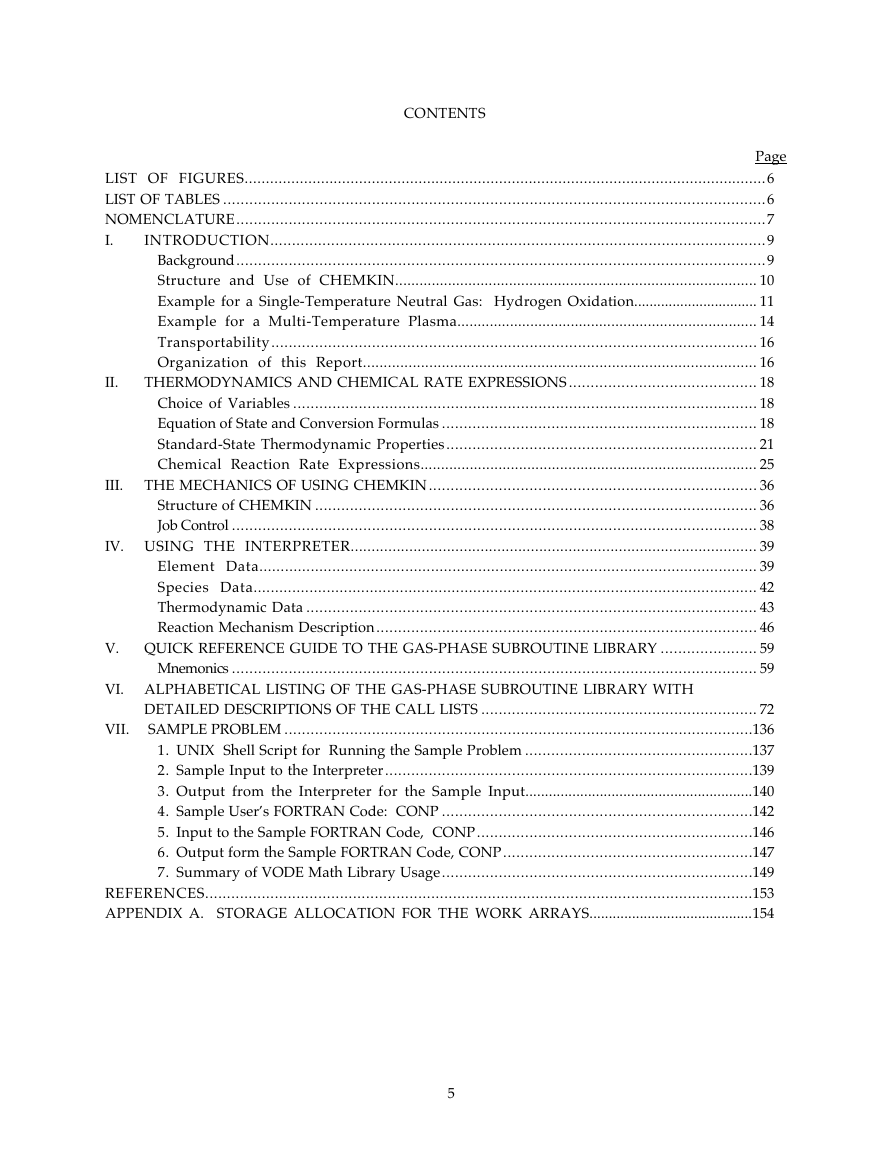
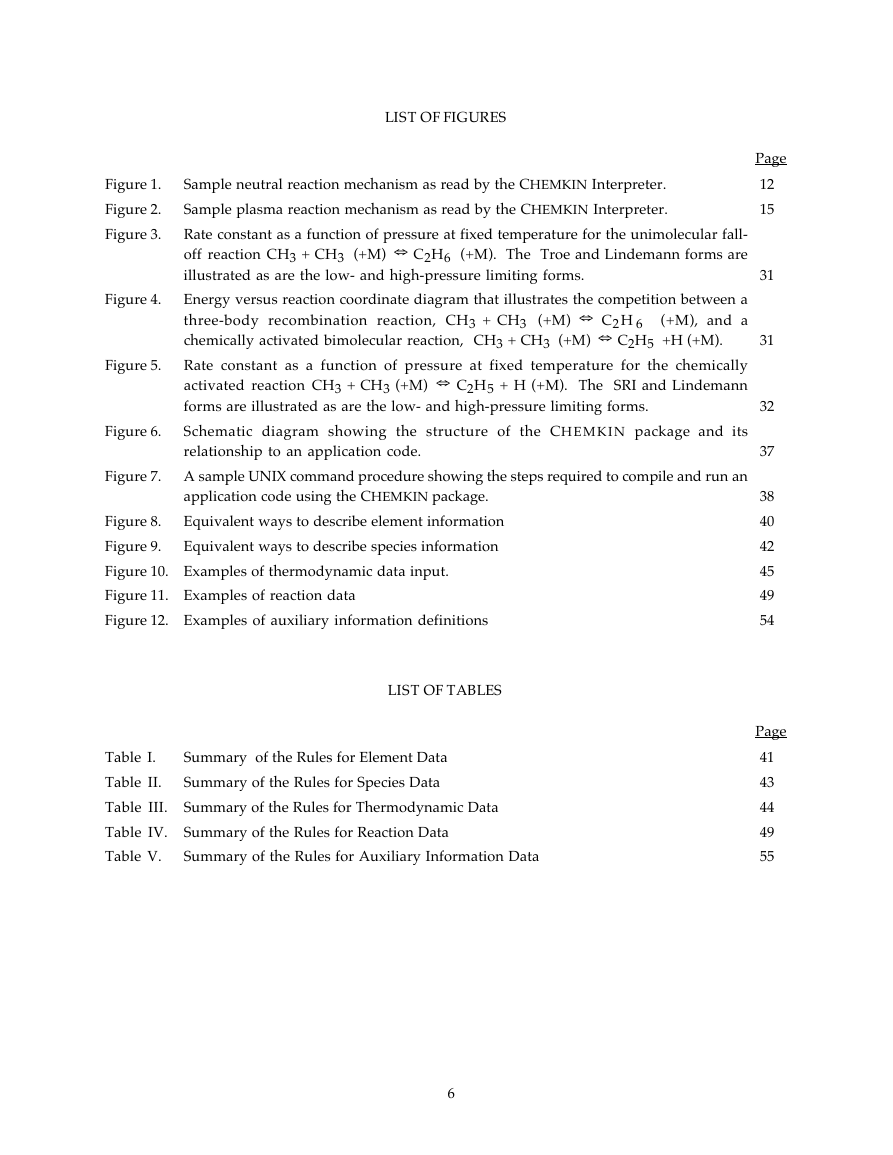
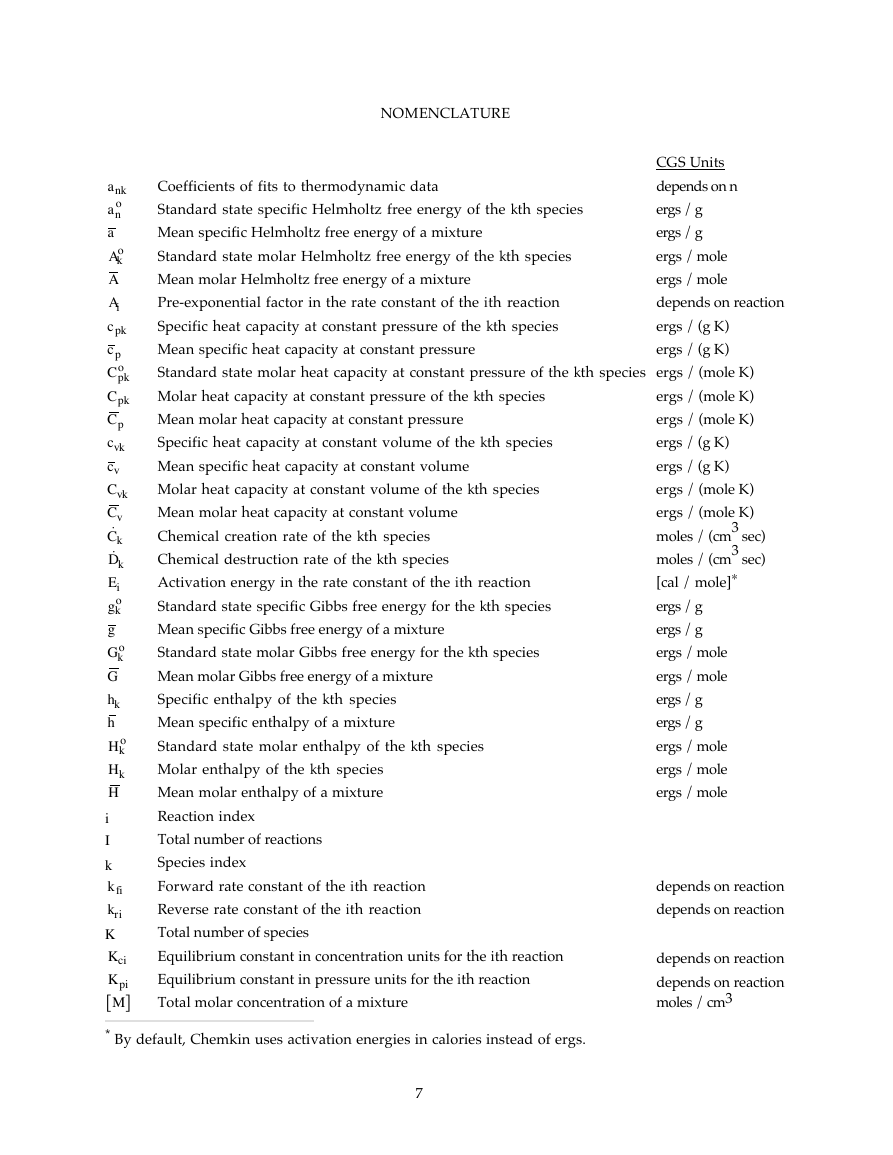
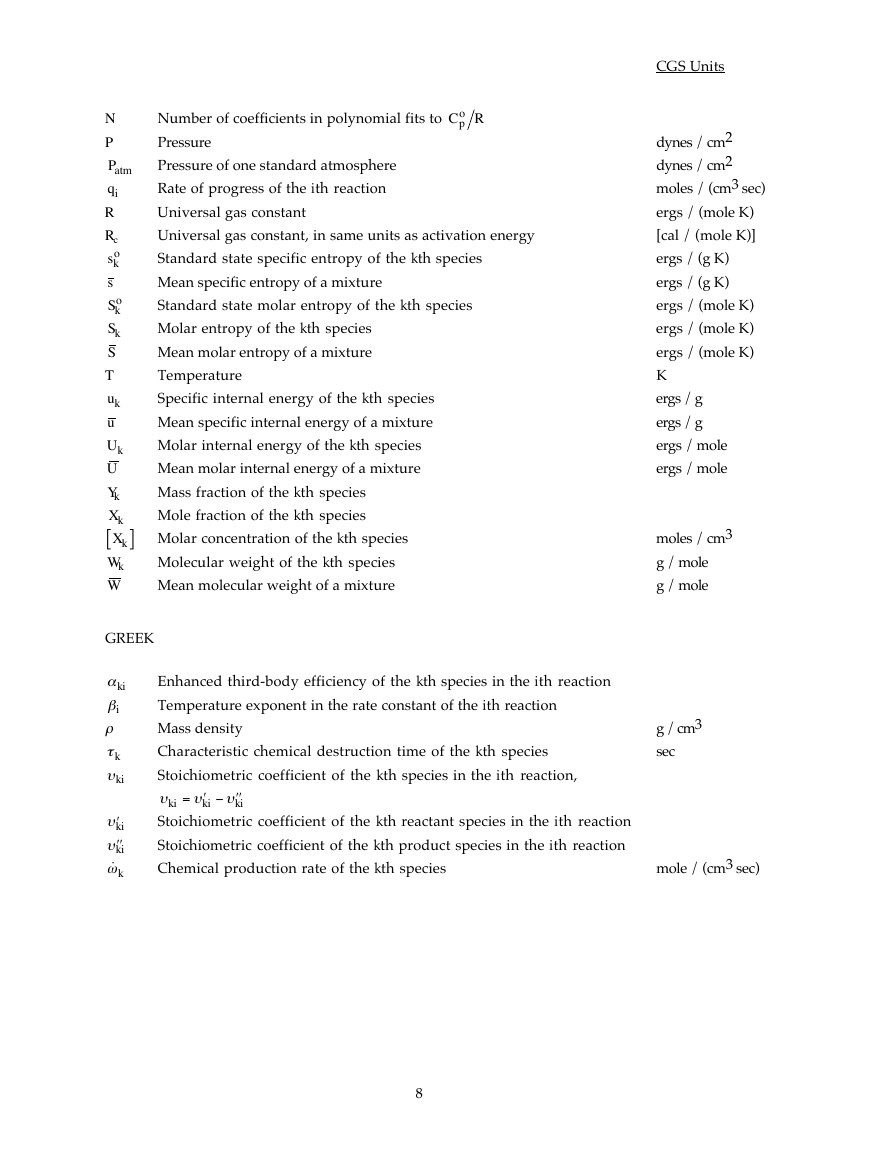

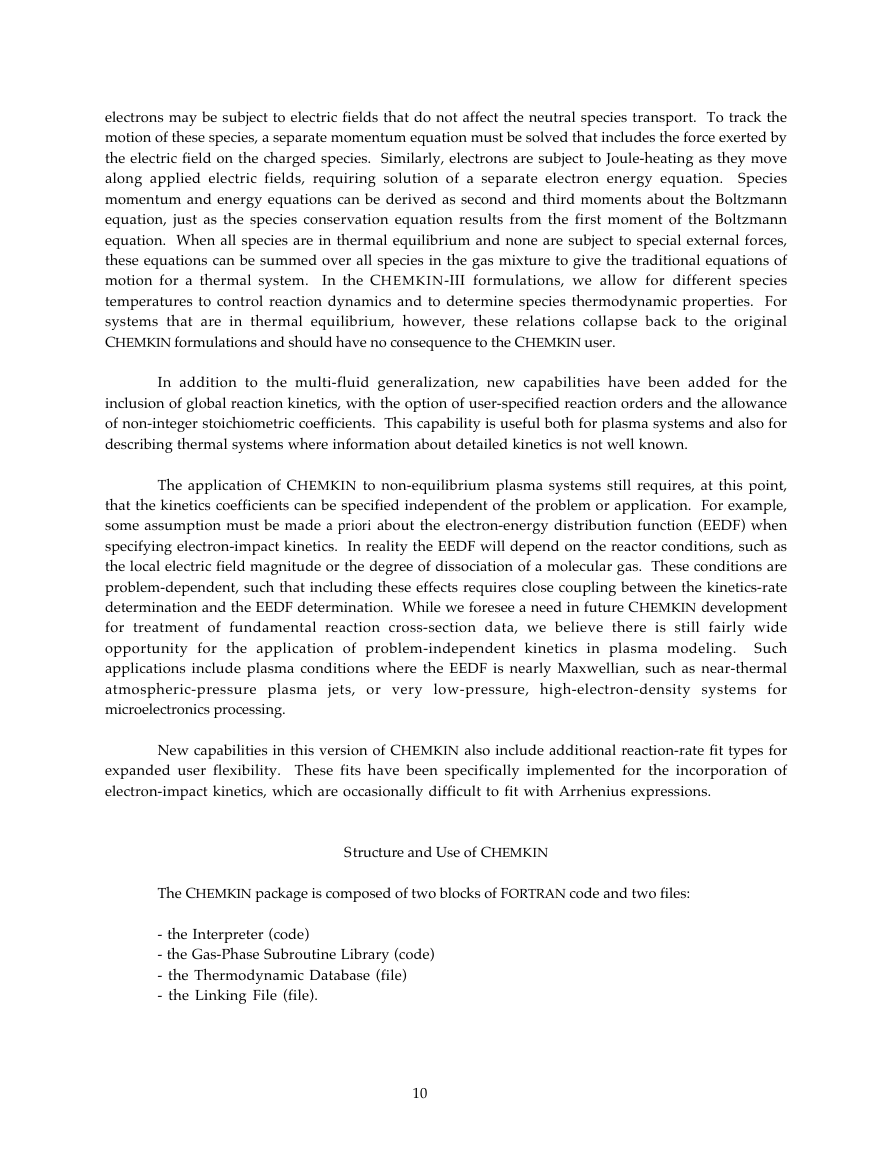








 2023年江西萍乡中考道德与法治真题及答案.doc
2023年江西萍乡中考道德与法治真题及答案.doc 2012年重庆南川中考生物真题及答案.doc
2012年重庆南川中考生物真题及答案.doc 2013年江西师范大学地理学综合及文艺理论基础考研真题.doc
2013年江西师范大学地理学综合及文艺理论基础考研真题.doc 2020年四川甘孜小升初语文真题及答案I卷.doc
2020年四川甘孜小升初语文真题及答案I卷.doc 2020年注册岩土工程师专业基础考试真题及答案.doc
2020年注册岩土工程师专业基础考试真题及答案.doc 2023-2024学年福建省厦门市九年级上学期数学月考试题及答案.doc
2023-2024学年福建省厦门市九年级上学期数学月考试题及答案.doc 2021-2022学年辽宁省沈阳市大东区九年级上学期语文期末试题及答案.doc
2021-2022学年辽宁省沈阳市大东区九年级上学期语文期末试题及答案.doc 2022-2023学年北京东城区初三第一学期物理期末试卷及答案.doc
2022-2023学年北京东城区初三第一学期物理期末试卷及答案.doc 2018上半年江西教师资格初中地理学科知识与教学能力真题及答案.doc
2018上半年江西教师资格初中地理学科知识与教学能力真题及答案.doc 2012年河北国家公务员申论考试真题及答案-省级.doc
2012年河北国家公务员申论考试真题及答案-省级.doc 2020-2021学年江苏省扬州市江都区邵樊片九年级上学期数学第一次质量检测试题及答案.doc
2020-2021学年江苏省扬州市江都区邵樊片九年级上学期数学第一次质量检测试题及答案.doc 2022下半年黑龙江教师资格证中学综合素质真题及答案.doc
2022下半年黑龙江教师资格证中学综合素质真题及答案.doc